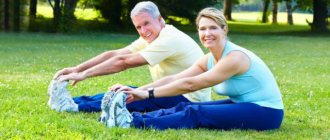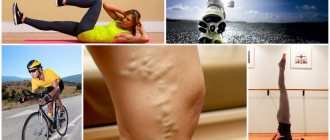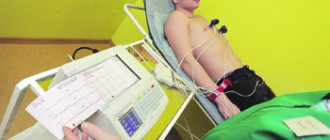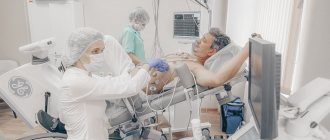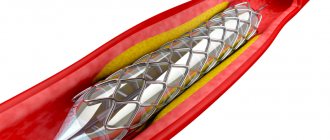Yoga to improve cerebral circulation will help strengthen existing health and get rid of various ailments. Exercises are good for blood vessels and the heart. Yoga to improve cerebral circulation
To treat various diseases, some practice unconventional methods. This is acupuncture (see Acupuncture for headaches), oriental medicine, and philosophical practices. Yoga is also used to improve cerebral circulation. It is traditionally believed that you need to be in perfect health to practice. If you use the right exercises, yoga therapy will help strengthen your existing health and get rid of various ailments.
What is yoga?
Translated from Sanskrit, yoga means “unity, union.” This implies the unification into a harmonious connection of three principles: physical, mental and spiritual. To do this, they resort to a system of gymnastic and breathing exercises, relaxation and meditation methods.
It is a mistake to believe that yoga is a religion. It refers to a philosophical movement that forms a certain attitude towards the environment and puts thoughts in a good mood. For this practice, there are some nutritional recommendations that help improve metabolism and overall well-being. But they do not require unquestioning execution and acceptance of vegetarianism. Everything should happen based on the needs of the body, the sensations that are born in a person.
The basis of the exercises is stretching. Therefore, beginners are encouraged to start with the simplest poses - asanas. But stretching is not the main goal. It helps relax muscles, teaches you to work with breathing, and puts your thoughts in order.
Effective medications for the treatment of hypertension: groups of drugs, recommendations.
All about herbs for blood pressure: action, analogues of drugs.
Research on stress and brain health
A study conducted at the University of Texas Health Science Center at San Antonio found that high levels of stress can increase the risk of memory loss and brain atrophy as early as middle age. These results are based on a study of more than 2,000 men and women who had no symptoms of dementia at the start of the study. All subjects were part of the larger Framingham Heart Study, a long-term health research project involving Massachusetts residents.
Participants went through a series of tests, taking part in several psychological examinations that assessed their cognitive abilities. About eight years later, when the average age of the volunteers was just 48, follow-up testing was conducted. During these sessions, blood samples were taken before breakfast, on an empty stomach, to determine serum cortisol levels. In addition, brain scans were performed using MRI, and the same series of psychological tests carried out years earlier were repeated.
Yoga for hypertension
This disease can exist independently or accompany diabetes, heart disease, and kidney disease. Yoga for hypertension offers some asanas, but caution should be taken. In this case, the exercises have the following goals:
- stretch the shoulder muscles;
- strengthen the thoracic region;
- relieve tightness in the cervical area;
- calm the nervous system;
- relax your muscles.
Yoga is contraindicated for hypertension, which is associated with the following poses:
- holding your breath;
- raising the lower limbs and pelvis from a lying position;
- bending back and bending in the back;
- inverted poses.
If weakness and malaise appear during exercise, you need to lie on your back and breathe.
Recommended asanas
- Anuloma-viloma pranayama is performed first, this is breathing through the nostrils in turn. First, cover the right one with your finger and inhale. Then press the left one - exhale. This is one cycle. You need to complete up to 8 cycles depending on how you feel.
- Goasana - table pose. Get on all fours, body parallel to the floor. Arms and legs are strictly perpendicular to the body. Take turns stretching the heel of the left foot and the opposite arm forward. Then they are returned to their original position, and the same is repeated on the other side.
- Cat pose. Starting position as in the previous asana. When you inhale, you arch your back, and when you exhale, you bend down. Perform up to 8 repetitions. The exercise relaxes the neck muscles, tones the shoulder girdle and back.
- Mountain pose. The foot is pressed tightly to the floor, the toes are spread to the sides. The knees and hips are strained, the tailbone is directed downwards. They try to straighten their chest and straighten their shoulders. The hands are pulled down and the top of the head is pulled up. Breathe deeply 5-8 times. Then they rise on their tiptoes, stretching their arms as high as possible. Perform 8 breathing movements. After this, they bend forward parallel to the floor, clasping their elbows with their hands, trying to pull themselves up. Closing your eyes, lie on the floor. Take calm inhalations and exhalations.
Tips for Beginners
To make the exercises easy and bring only benefits, you need to follow the rules of safe exercise:
- exercise only in a good mood;
- ventilate the room before classes;
- When performing exercises, do not be distracted by extraneous thoughts;
- while performing asanas, do not overexert yourself and prevent pain from occurring;
- If classes cause discomfort, you should stop and choose a different technique.
You need to end the lesson with complete relaxation. After a burst of activity, the brain needs to return to normal operation, otherwise the person will quickly become overtired. This can lead to the development of insomnia and neurosis.
Yoga for heart disease
Coronary heart disease is of primary importance for circulatory disorders. Yoga for the heart and blood vessels implies the following rules:
- active practice is excluded;
- static poses are prohibited;
- you should not perform asanas that increase gastric secretion or strain the abdominal muscles;
- Turning over is not recommended.
All about the prevention of hypertensive crisis: effective methods.
Some yoga exercises for blood vessels
- Head tilts. In a standing position, legs together perform head tilts to the sides alternately and turns.
- Shoulder rotations. Starting position is vertical, legs together. The arms are spread out to the sides parallel to the floor. Twist the shoulder joint back and forth.
- Rotation at the elbows is performed in the same position, but the arms are bent at the elbow joint and rotated forward and backward.
- Exercise for hands. Stretch your arms forward. Stretch your hands as much as possible, palms forward, then lower them down and stretch them again.
- The cat pose is suitable for hypertension.
- Sitting on the floor, legs extended forward. A strap is placed over the lower arch of the foot. As you inhale, pull the bent leg towards you, and as you exhale, straighten it. Repeat for each side separately. If you feel sufficient strength, you can perform the exercise without a belt.
- Gomukhasana is a twisting pose sitting on the heels. Interlace your legs and sit on the floor. Throw your hand behind your head, and place the other behind your back, try to clasp your fingers in a lock on your back. This asana requires some stretching. If it is insufficient, you can simplify the task and use a belt.
For heart disease, it is recommended to fully master the special breathing of yogis. You can learn more about yoga for osteochondrosis from the following video:
Self-practicing yoga may not be done entirely correctly. What is important here is the rotation of the foot, the position of the hands, the tension or relaxation of a certain part of the body and the rhythm of breathing. Therefore, it is better to start your first classes with an instructor or a person who has been successfully practicing such exercises for a long time.
Gymnastics for the blood vessels of the brain and neck
ORDER ON THE OFFICIAL STORE WEBSITE
Contraindications for yoga
You cannot perform inverted asanas if you have diseases of the cardiovascular system or osteochondrosis. Exercise accelerates blood flow, increasing pressure on the walls of blood vessels. If the vessels are pinched by salt deposits, the blood cannot circulate normally and the outgoing capillaries may burst. Also, inverted asanas can provoke an increase in intracranial pressure, so you should consult a doctor before starting classes.
In the early stages of dementia, the following factors are important:
For a person with dementia, it is important to create a quiet, homely, familiar atmosphere. Moreover, the circle of people with whom he communicates must be constant. This will eliminate feelings of anxiety, nervousness, confusion and excitement. It’s a good idea to create a daily routine and stick to it strictly.
Lyudmila Zhilevich: “Unfamiliar faces, new situations that a person is no longer able to remember, can provoke an acceleration of the development of the disease, and also negatively affect his condition.”
The first symptoms of dementia are not a reason to give up exercise. This could be walking in your favorite places, simple work in the garden, physical therapy exercises (at least 150 minutes of anaerobic exercise weekly).
Life should be full of various events and types of intellectual activity. You can read, solve crosswords and scanwords, play chess or checkers, discuss past cultural or political events.
It is important for the patient to have a hobby, but it should not only be a source of positive emotions and bring pleasure, but also stimulate cognitive and mental abilities.
A sick person's diet should contain foods that lower cholesterol levels. For example, barley, legumes, blueberries. Instead of butter, it is better to give preference to vegetable oil. The menu can include fermented milk products, lean meats and poultry, lean fish, seafood, and sauerkraut. To improve the taste of dishes, the use of seasonings (sage, cinnamon, turmeric, saffron) is allowed. But it is better to reduce salt consumption to a minimum. You should definitely drink the daily amount of clean water (at the rate of 30 ml per 1 kg of weight). It is better to cook by steaming, you can bake or boil.
If you follow all the doctor’s recommendations, you can slow down the progression of the disease, which means significantly improving the patient’s quality of life and delaying severe manifestations of dementia. At the same time, people who have a hereditary predisposition to developing the disease should pay special attention to prevention: lead a healthy lifestyle, do exercises daily for mental exercise, and control blood cholesterol levels.
An important point is to create comfortable conditions so that a person suffering from dementia remains independent for as long as possible. The best therapy is to spend more time with elderly relatives, surround them with love, care, and help them feel useful and needed, the specialist added.
First signs of dementia
- Both long-term and short-term memory are impaired. It becomes difficult for a person to remember events that happened recently or remember new information.
- A person loses the skills of orientation in space and time. It is not uncommon for patients to become lost even in areas familiar to them.
- Indifference to once-loved activities appears, and the desire to learn new things disappears. This happens because the brain is no longer able to receive and process information.
- Reducing the criticality of one's own perception. Usually this symptom appears when planning the next period of life.
- In the future, both the progression of these symptoms and the appearance of others, more powerful in their effects, are noted. One of the clear hallmarks of dementia is that a person lives in his past.
At the earliest manifestations of the disease, it is important to promptly consult a therapist or general practitioner. If necessary, he will refer the patient to a specialist (neurologist, psychiatrist or geriatrician).

